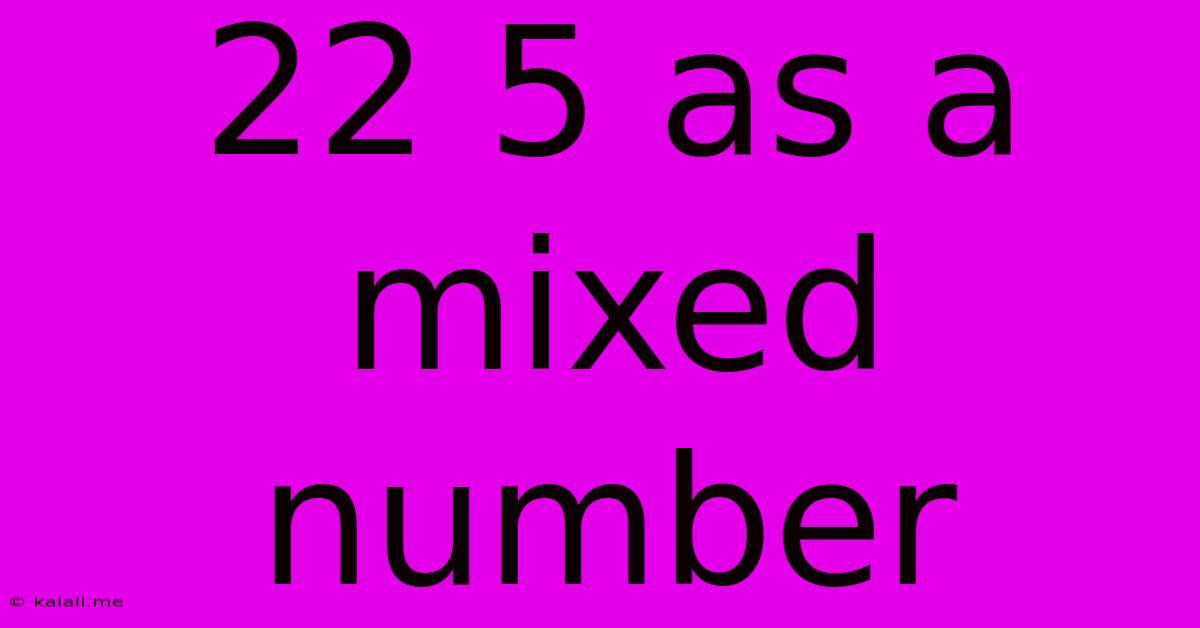22 5 As A Mixed Number
Kalali
May 09, 2025 · 2 min read

Table of Contents
22/5 as a Mixed Number: A Simple Explanation
Converting an improper fraction like 22/5 into a mixed number is a fundamental skill in arithmetic. This article will guide you through the process, explaining the concept clearly and offering examples to solidify your understanding. Understanding this conversion is crucial for various mathematical operations and problem-solving scenarios.
What is a Mixed Number?
A mixed number combines a whole number and a proper fraction. A proper fraction is a fraction where the numerator (the top number) is smaller than the denominator (the bottom number). For example, 1 ½, 3 ¼, and 2 ⅔ are all mixed numbers. They represent a quantity that's more than one whole unit.
Converting 22/5 to a Mixed Number:
The process of converting an improper fraction (where the numerator is larger than the denominator) to a mixed number involves division. Here's how to convert 22/5:
-
Divide the numerator by the denominator: Divide 22 by 5.
22 ÷ 5 = 4 with a remainder of 2
-
Identify the whole number: The quotient (the result of the division) becomes the whole number part of your mixed number. In this case, the quotient is 4.
-
Identify the fraction: The remainder becomes the numerator of the fraction, and the denominator remains the same as the original fraction. So, the remainder of 2 becomes the numerator, and the denominator stays as 5. This gives us the fraction 2/5.
-
Combine the whole number and the fraction: Combine the whole number (4) and the fraction (2/5) to form the mixed number.
Therefore, 22/5 as a mixed number is 4 2/5.
Let's Practice with More Examples:
To further solidify your understanding, let's try converting a few more improper fractions to mixed numbers:
-
17/3: 17 ÷ 3 = 5 with a remainder of 2. Therefore, 17/3 = 5 ⅔
-
25/4: 25 ÷ 4 = 6 with a remainder of 1. Therefore, 25/4 = 6 ¼
-
31/6: 31 ÷ 6 = 5 with a remainder of 1. Therefore, 31/6 = 5 ⅚
Why is this Conversion Important?
Converting improper fractions to mixed numbers is essential for several reasons:
-
Easier Understanding: Mixed numbers often provide a more intuitive and easier-to-understand representation of a quantity than improper fractions, especially in real-world applications. Imagine measuring ingredients for a recipe; 4 2/5 cups of flour is clearer than 22/5 cups.
-
Simplifying Calculations: In some calculations, using mixed numbers can simplify the process and make it easier to visualize the result.
-
Problem Solving: Many word problems and real-life situations involve quantities that are better represented as mixed numbers.
By mastering the conversion of improper fractions to mixed numbers, you enhance your mathematical skills and improve your ability to solve a wider range of problems effectively. Remember the simple steps: divide, identify the whole number and fraction, and combine them!
Latest Posts
Latest Posts
-
60 Inches To Feet And Inches
May 09, 2025
-
How Many Kilograms Is 5000 Grams
May 09, 2025
-
18 Is What Percent Of 75
May 09, 2025
-
What Number Is Equivalent To 1 3
May 09, 2025
-
Cuanto Es 34 Fahrenheit En Centigrados
May 09, 2025
Related Post
Thank you for visiting our website which covers about 22 5 As A Mixed Number . We hope the information provided has been useful to you. Feel free to contact us if you have any questions or need further assistance. See you next time and don't miss to bookmark.